ignition AUDI A5 COUPE 2010 Owners Manual
[x] Cancel search | Manufacturer: AUDI, Model Year: 2010, Model line: A5 COUPE, Model: AUDI A5 COUPE 2010Pages: 360, PDF Size: 84.39 MB
Page 265 of 360

_____________________________________________ C_ l_ e _a_ n_ in_ g_a _ n_d_ p_ r_ o_ t _e_ c_t _io _ n __ lffllll
•
- Dab at the stain. Start at the outside and work inwards.
- Once the stain is no longer v isible, use a soft dry cloth or
tissue to soak up the moisture.
Do not use lea ther cleaning produc ts on Alcantara®.
You may use a suitable shampoo for removing dust and dirt.
Dust and grit in the pores and seams can scratch and damage the
surface. If the car is left standing in the sun for long periods, the
Alcantara® should be protected against direct sunlight to prevent it
from fading. Slight color variations will develop in normal use and are not an indication of material deterioration.
0 Note
• Never use chemical solvents (e.g. lighter fluid, turpentine),
waxes , shoe polish or similar products on Alcantara ® surfaces.
• To avoid damage, have stubborn stains removed by a commer
cial cleaning specialist.
• Do not use brushes, stiff sponges or similarly abrasive cleaning
aids. •
Safety belts
Only well-maintained safety belts work reliably when
needed.
- Keep belts clean.
- For cleaning, use a mild soap and water solution . Let
belts dry thoroughly and away from direct sunlight.
- Do not allow inertia reel safety belts to retract before
they are completely dry.
- Check the condition of your safety belts
regularly.
Heavily soiled safety belts may not retract properly .
& WARNING
Damaged safety belts can break in a crash.
• Anything that might damage your safety belts could mean that
you and your passengers would not be adequately protected in an
accident.
• Safety belt performance depends on correct installation. Never
remove belts from the vehicle to clean them .
• Do not use chemical cleaning agents, bleach or dyes. They have
corrosive properties which weaken the webbing.
• When cleaning your safety belts, inspect them for damage. If
you discover damage, see your authorized Audi dealer.
• Always read and heed all WARNINGS and other information
=> page 252. •
Engine compartment
Be especially careful when cleaning the engine comport
ment.
Always switch off the ignition before cleaning the engine => &.
Plenum panel
Remove leaves from the plenum panel in front of the windshield
under the engine hood. This prevents the water drain holes from
becoming blocked, and it prevents debris from entering the vehicle
interior through the heating and ventilation ducts .
Corrosion protection
The engine compartment and transmission have been corrosion
protected at the factory.
Good anti-corrosion treatment is very important, particularly in the
winter. If the vehicle is frequently driven on salt treated roads, the .,_
Vehicle care I t •
Page 266 of 360
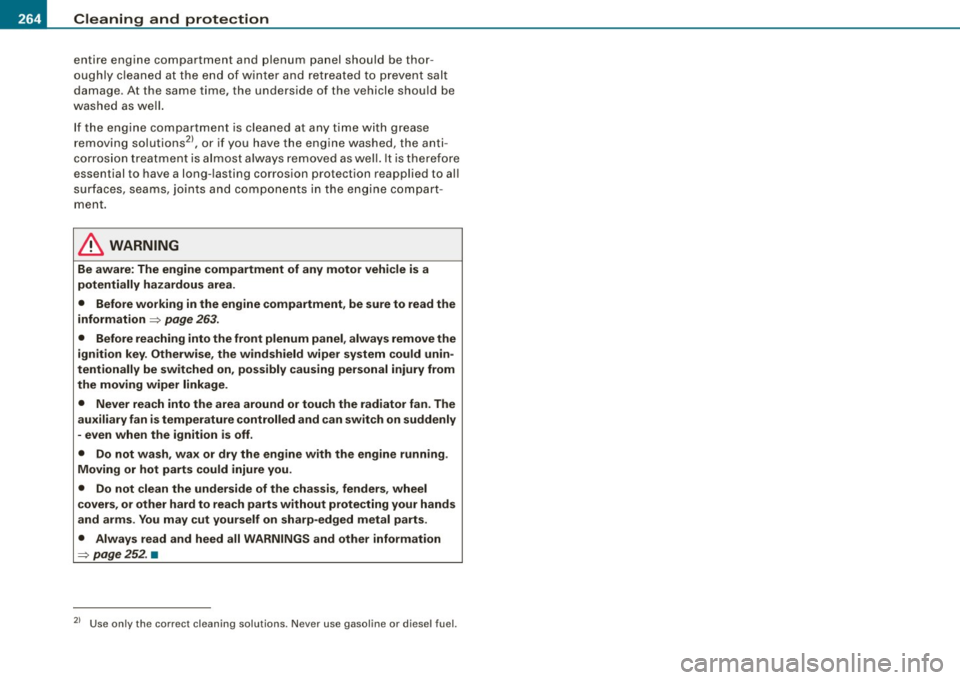
___ C_ le_ a _ n_i_n ~g _ a_ n_ d __ p_r _o _t _e _c_ t_ i_o _n ___________________________________________ _
entire engine compartment and plenum panel should be thor
oughly cleaned at t he end of winter and retreated to prevent sal t
damage . At the same time, the underside of the vehicle shou ld be
washed as we ll.
If the eng ine compartment is cleaned at any t ime with grease
removing solutions
2 l, or if you have the engine washed, the anti
corrosion treat ment is al most a lways removed as wel l. It is there fore
essential to hav e a long- las ting corrosion protection r eapplied to al l
sur faces, sea ms, joints a nd co mponents in the engine compar t
ment.
& WARNING
Be awa re: The engine compartment of any motor vehi cle is a
potentially hazardou s area.
• Before working in the engine compartment , be sure to read the
information
::::> page 26 3.
• Before reaching into the front p lenum panel, always remove the
ignition key . Otherwise , the w ind shield wiper sy stem cou ld unin
tentionally be sw itched on, pos sibly causing personal in jury from
the moving wiper linkage .
• Never reach into the area around or touch the radiator fan . The
a uxil iary f an i s temperature controlled and can switch on suddenly
- even when the ignition is off.
• Do not wash , wa x or dry the eng ine with the e ngine running .
Moving or hot part s could injure you .
• Do not clean the underside of the chassis , fenders , wheel
c overs , or other hard to reach parts without protecting your hands
a nd arms . You may cut yourself on sharp-edged met al parts .
• Always read and heed all WARNINGS and other informat ion
=> page 2 52 . •
21 Us e on ly th e correct c lean ing solut ions. N ev er use gasolin e or di esel fuel.
Page 267 of 360
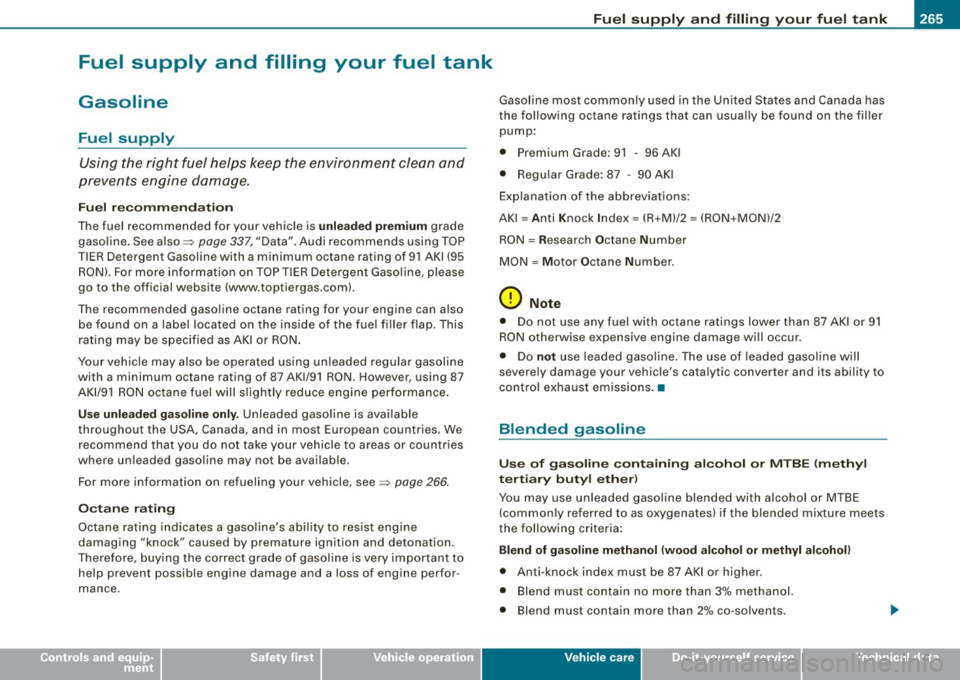
•
Fuel supply and filling your fuel tank
Gasoline
Fuel supply Using the right fuel helps keep the environment clean and
prevents engine damage.
Fuel r ecomm end ati on
The fuel recommended for your vehic le is unl eade d prem ium grade
gaso line . See also ~
page 337, "Data". Audi recommends using TOP
T IER Detergent Gasoline with a minimum octane rating of 91 AKI (95
RON). For more information on TOP TIER Detergent Gaso line, please
go to the official website (www.toptiergas .com).
The recommended gasoline octane rating for your engine can also be found on a label located on the inside of the fuel fille r flap. This
rating may be specified as AK I or RON .
Your vehic le may also be operated us ing unleaded regular gasoline
with a minimum octane rating of 87 AKl/91 RON . However, using 87
AKl/9 1 RON octane fuel will slightly reduce engine performance.
Use unle ad ed ga so line only . Unleaded gaso line is avai lable
throughout the USA, Canada, and in most European countries. We
recommend that you do not take your vehicle to areas or countr ies
where un leaded gasoline may not be available .
For more information on refueling your vehicle, see~
page 266 .
Octane ra tin g
Octane rating indicates a gaso line's ability to resist engine
damaging "knock" caused by premature ignition and detonation.
Therefore, buying the correct grade of gaso line is very important to
help prevent possible engine damage and a loss of engine perfor
mance.
F ue l supply and fillin g you r fu el tank
Gasoline most common ly used in the United States and Canada has
the following octane ratings that can usua lly be found on the filler
pump:
• Premium Grade : 91 -96 AKI
• Regular Grade: 87 -90 AKI
Explanation of the abbreviations:
AKI = Anti Knock Index= (R +M)/2 = (RON +MON)/2
RON = Research Octane Number
MON
= M otor Octane Number .
0 Note
• Do not use any fue l with octane ratings lower than 87 AKI or 91
RON otherwise expensive engine damage will occur .
• Do
not use leaded gasoline. The use of leaded gasoline w ill
severe ly damage your vehicle's catalytic converter and its abi lity to
control exhaust emissions. •
Blended gasoline
Use of g aso line containing alco hol or M TB E ( meth yl
t er tiary butyl e ther )
You may use unleaded gasoline blended with alcohol or MTBE
(commonly referred to as oxygenates) if the blended mixture meets
the follow ing criteria:
Bl end of g asoline m eth anol (wood al coho l or methyl alc oh ol)
• Anti-knock index must be 87 AKI or higher .
• Blend must contain no more than 3% methanol.
• Blend must contain more than 2% co-solvents.
Vehicle care I t •
Page 271 of 360
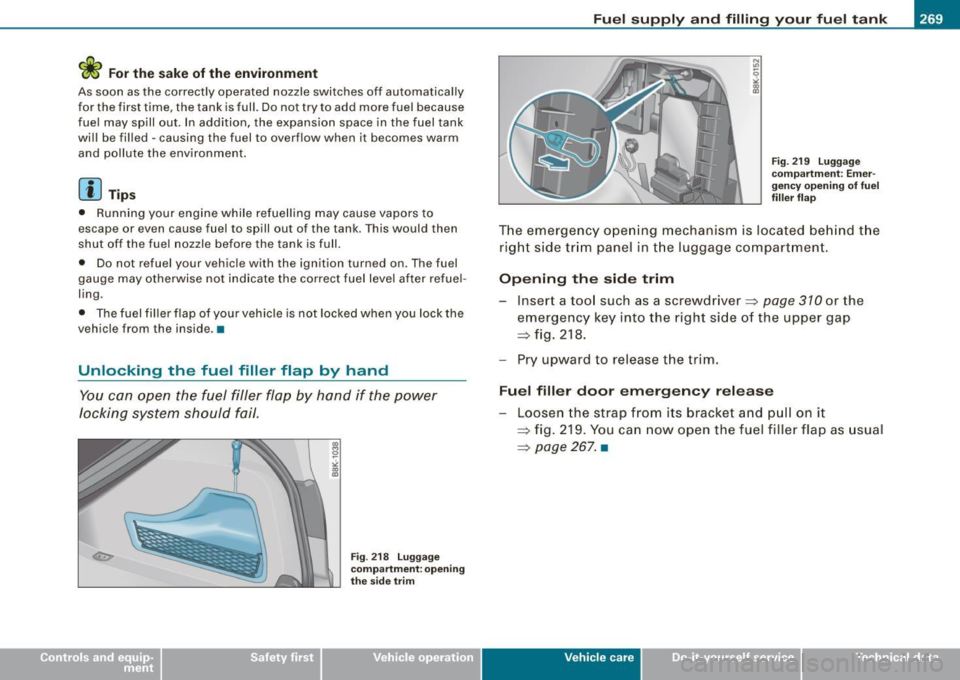
<£> For the sake of the environment
As soon as the correctly operated nozzle switches off automatically
for the first time, the tank is full. Do not try to add more fuel because
fuel may spill out. In addition, the expansion space in the fuel tank
will be filled -causing the fuel to overflow when it becomes warm
and pollute the environment.
[ i] Tips
• Running your engine while refuelling may cause vapors to
escape or even cause fuel to spill out of the tank. This would then
shut off the fuel nozzle before the tank is full.
• Do not refuel your vehicle with the ignition turned on. The fuel
gauge may otherwise not indicate the correct fuel level after refuel
ling .
• The fuel filler flap of your vehicle is not locked when you lock the
vehicle from the inside .•
Unlocking the fuel filler flap by hand
You can open the fuel filler flap by hand if the power
locking system should fail.
Fig . 218 Luggage
compartment : opening
the side trim
Fuel supply and filling your fuel tank
Fig. 219 Luggage
compartment: Emer
gency opening of fuel
filler flap
The emergency opening mechanism is located behind the
right side trim panel in the luggage compartment.
Opening the side trim
- Insert a tool such as a screwdriver=:>
page 310 or the
emergency key into the right side of the upper gap
=:> fig. 218.
- Pry upward to release the trim.
Fuel filler door emergency release
- Loosen the strap from its bracket and pull on it
=:> fig. 219. You can now open the fuel filler flap as usual
=:> page 267. •
Vehic le care I I irechnical data
Page 273 of 360
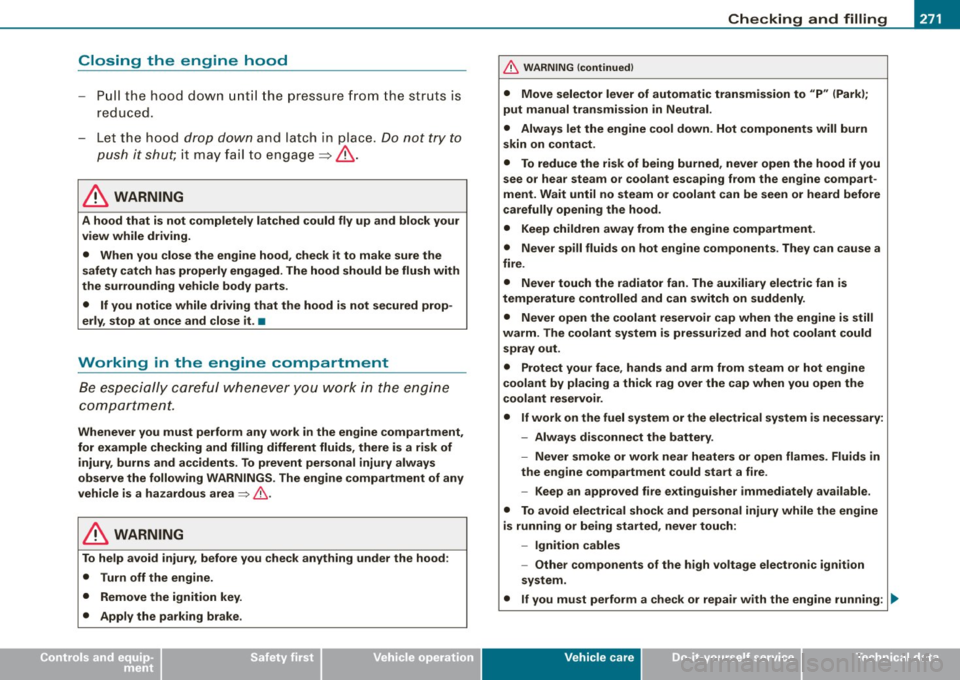
Checking and filling IJI
--------------~-
•
Closing the engine hood
-Pull the hood down until the pressure from the struts is
reduced .
- Let the hood
drop down and latch in place. Do not try to
push it shut;
it may fail to engage => &.
& WARNING
A hood that is not completely latched could fly up and block your
view while driving.
• When you close the engine hood, check it to make sure the
safety catch has properly engaged. The hood should be flush with
the surrounding vehicle body parts.
• If you notice while driving that the hood is not secured prop
erly, stop at once and close it. •
Working in the engine compartment
Be especially careful whenever you work in the engine
compartment.
Whenever you must perform any work in the engine compartment,
for example checking and filling different fluids, there is a risk of injury, burns and accidents. To prevent personal injury always
observe the following WARNINGS. The engine compartment of any
vehicle is a hazardous area
~ & .
& WARNING
To help avoid injury, before you check anything under the hood :
• Turn off the engine.
• Remove the ignition key.
• Apply the parking brake .
& WARNING (continued)
• Move selector lever of automatic transmission to "P" (Park);
put manual transmission in Neutral .
• Always let the engine cool down. Hot components will burn
skin on contact.
• To reduce the risk of being burned, never open the hood if you
see or hear steam or coolant escaping from the engine compart
ment. Wait until no steam or coolant can be seen or heard before
carefully opening the hood .
• Keep children away from the engine compartment.
• Never spill fluids on hot engine components . They can cause a
fire.
• Never touch the radiator fan. The auxiliary electric fan is
temperature controlled and can switch on suddenly.
• Never open the coolant reservoir cap when the engine is still
warm. The coolant system is pressurized and hot coolant could
spray out.
• Protect your face, hands and arm from steam or hot engine
coolant by placing a thick rag over the cap when you open the
coolant reservoir.
• If work on the fuel system or the electrical system is necessary:
- Always disconnect the battery.
- Never smoke or work near heaters or open flames. Fluids in
the engine compartment could start a fire .
- Keep an approved fire extinguisher immediately available.
• To avoid electrical shock and personal injury while the engine
is running or being started, never touch :
- Ignition cables
- Other components of the high voltage electronic ignition
system.
• If you must perform a check or repair with the engine running: ..,
Vehicle care
I t •
Page 277 of 360
![AUDI A5 COUPE 2010 Owners Manual Checking and filling -
-----------------=-----==-----...J
0 Note
Driving with an insufficient oil level is likely to cause severe damage
to the engine.
[ i] Tips
• The oil pressu AUDI A5 COUPE 2010 Owners Manual Checking and filling -
-----------------=-----==-----...J
0 Note
Driving with an insufficient oil level is likely to cause severe damage
to the engine.
[ i] Tips
• The oil pressu](/img/6/57582/w960_57582-276.png)
Checking and filling -
-----------------=-----==-----...J
0 Note
Driving with an insufficient oil level is likely to cause severe damage
to the engine.
[ i] Tips
• The oil pressure warning display~ is not an indicator of the oil
level. Do not rely on it. Instead, check the oil level in your engine at
regular intervals, preferably each time you refuel, and always before
going on a long trip.
• If you have the impression your engine consumes excessive
amounts of oil, we recommend that you consult an authorized Audi
dealer to have the cause of your concern properly diagnosed. Keep
in mind that the accurate measurement of oil consumption requires
great care and may take some time. An authorized Audi dealer has
instructions about how to measure oil consumption accurately. •
Checking the engine oil level
Read oil level
Fig. 223 MMI Display;
Oil level indicator
Select: Function button [CARI> Oil level.
- Park your vehicle so that it is horizontally level. Shut
the engine off when it is at operating temperature.
Wait approx. two minutes. Read the oil level in the MMI* Display=> fig. 223. Add
engine oil if the bar of the oil level indicator is near "Min"
=>
page 275
Depending on the way the vehicle is driven and the operating condi
tions, oil consumption can be up to a 1/2 quart per 600 miles (0.5
liter per 1000 kml. Consumption may be higher within the first 3000
miles (5000 kml.
[ i] Tips
The oil level indicator in the MMI* Display is only an information
display. If the oil level is too low, a minimum oil warning appears in
the instrument cluster. Add oil
=> page 275. If the hood has been
opened, the current oil level is shown in the instrument cluster the
next time the ignition is switched on. •
Adding engine oil ~
Fig. 224 Engine
compartment; Oil filler
cap location
Before you check anything in the engine compartment,
always read and heed all WARNINGS=> & in "Working in
the engine compartment" on
page 271. .,,_
Vehicle care I I irechnical data
Page 284 of 360

-~_C_ h_e _c _ k_ i_n ...:::g::;...._ a_n_ d_ f_ i_ll _in -'g:::;.._ ___________________________________________ _
Have the battery checked when you take your vehicle in for service.
You are well advised to replace a battery that is older than 5 years.
With certain types of airbag deployment, the battery is discon nected from the vehicle electrical system for safety reasons=>
& in
"Repair, care and disposal of the airbags" on
page 202.
Disconnecting the battery terminals
Some vehicle functions (power window regulators, for example) are
lost if the battery terminals are disconnected. These functions have
to be relearned after the battery terminals are connected again . To
prevent this, the battery should only be disconnected from the
vehic le electr ical system when absolute ly necessary for repairs .
Vehicles not driven for long periods
If you do not drive your vehicle over a period of several days or
weeks, electrical components are gradually cut back or switched off.
This reduces energy consumption and maintains starting capability
over a longer period=>
page 241.
Take into consideration that when you unlock your vehicle, some
convenience functions, such as the master key remote function or power seat adjustment, may not be available. The convenience
functions will be available again when you turn on the ignition and start the engine .
Winter operation
During the winter months, battery capacity tends to decrease as
temperatures drop . This is because more power is also consumed
while starting, and the headlights, rear window defogger, etc., are
used more often.
Avoid unnecessary power consumption, particularly in city traffic or
when traveling only short distances . Let your authorized Audi dea ler
check the capacity of the vehicle battery before winter sets in
=>
page 284 . A well charged battery will not only prevent starting
problems when the weather is cold, but will also last longer.
[ i ] Tips
If your vehicle is left standing for several weeks at extremely low
temperatures, the vehicle battery should be removed and stored
where it will not freeze. This will prevent it from being damaged and
having to be replaced. •
Working on the battery
Be especially careful when working on or near the battery.
The battery is located in the luggage compartment under
the floor. Before you check anything in the luggage
compartment,
read and heed all WARNINGS =:>& .
Always heed the safety warnings, when working on the vehicle
battery or the vehicle electrical system to prevent injury.
The following WARNINGS are very important when
working on the battery:
Always heed the following WARNING SYMBOLS and safety pre
cautions when working on the battery.
Always wear eye protection .
Battery acid contains sulfuric acid. Always wear
gloves and eye protection.
Page 285 of 360

Checking and filling 111111
---------------------------=----
•
®
No
-sparks
- flames
- smoking .
When a battery is charged, it produces hydrogen
gas which is explosive and could cause personal
injury .
Always keep the battery well out of reach of chil
dren .
_& WARNING
Whenever working on the battery or on the electrical system ,
there is the risk of injury , accident and even fire . Read and heed the
following WARNINGS:
• Always wear eye protection . Do not let battery acid or any lead
particles get on your skin or clothing. Shield your eyes. Explosive
gases can cause blindness or other injury.
• Battery acid contains sulfuric acid . Sulfuric acid can cause
blindness and severe burns .
- Always wear gloves and eye protection . Do not tilt the
battery because acid could leak out of the ventilation openings .
- If you get battery acid in your eyes or on your skin, immedi
ately rinse with cold water for several minutes and get medical
attention.
- If you should ingest any battery acid , seek medical attention
immediately.
• Do not expose the battery to an open flame, electric sparks or
an open light.
• Do not smoke .
• Do not interchange the positive and negative cables .
• When working on the battery , be sure not to short -circuit the
terminals with tools or other metal objects . This would cause the
& WARNING (continued)
battery to heat up very quickly, which could lead to damage or
explosion and personal injury.
• When a battery is charged , it produces hydrogen gas which is
explosive and could cause personal injury .
• Always keep the battery well out of the reach of children. • Before work is done on the electrical system, disconnect the
negative ground cable .
• Before performing any work on the electrical system , switch off
the engine and ignition as well as any electrical equipment. The negative cable on the battery must be disconnected. If you are just
going to replace a light bulb, then it is enough to switch off the
lights.
• Before disconnecting the battery , switch off the anti -theft
alarm system! Otherwise you will set off the alarm .
• When disconnecting the battery , first disconnect the negative
cable and then the positive cable .
• Before reconnecting the battery, make sure all electrical
consumers are switched off . Reconnect the positive cable first and
then the negative cable . Never interchange the cables -this could
start a fire !
• Never charge a frozen or a thawed -out battery. It could
explode! If a battery has frozen, then it must be replaced . A
discharged battery can freeze over at 32 °F (0 °CI.
• Make sure the vent hose is always attached to the opening on
the side of the battery.
• Never use batteries which are damaged . There is the danger of
an explosion! Always replace a damaged battery .
_& WARNING
California Proposition 65 Warning:
Vehicle care
I t •
Page 286 of 360

___ C_h_ e_ c_k _in --== g'-- a_n _d_ f_il _li _n ..:::g:::..- ___________________________________________ _
& WARNING (c ont in ued)
• Batte ry po sts, te rmi nals a nd re late d accessor ies c ontain l ead
and l ead co mp ound s, chem ica ls know n to the S ta te o f Ca liforni a
to cause c ancer and repr odu ctive prob lems. Wa sh hands after
h andling.
0 Note
• Do not disconnect the vehicle battery when the ignition is
sw itched on or when the engine is running , otherwise, you wi ll
damage e lectron ic components in the e lectrical system .
• If your vehic le is going to s tand for a long period of time withou t
being driven, protect the battery from "freez ing", otherwise it will
be damaged and will then have to be replaced . •
Battery charging
Starting the engine requires a well charged battery.
Fig . 227 E ngin e
co mp artm ent : Co nnec
tors for charger and
jump er cab les
Alw ay s re ad and h eed all WARNINGS below => & and=> &
in "Worki ng o n the batte ry" on
page 282 .
-Turn off the ign it io n and all electrical consumers . -
Make s ure the area is well ven tilated when y ou charge
the battery .
- Open the eng ine hood =>
page 270.
- Open the red cover on the pos itive pole => fig . 227.
- Connect the charger connectors accord ing to the ins truc-
t ions to the
jump start bolt s. (Bolts under the red cover=
"positive", Bolts with hex head= "negative").
- Only now pl ug the mains lead for t he charging equi p
me nt in to the wa ll ou tlet and turn i t on =>& .
-Make sure the ch arging rate is not over 30 amp s/14.8
Volt .
-When the battery is fully charged: Turn the charging
equipment off and remove the mains lead from the wall
outlet .
- Now remove the clamps for the charging equipment .
- Close the red cover on the positive pole.
- Close the hood
=> page 271 .
A d ischarged battery can freeze at temperatures of only 32 °F (0 °C).
Allow a fro zen bat tery to thaw completely befor e attempting to
cha rge it=> & . However , we recommend not using a thawed battery
again because the ba ttery c asing can be cra cked due to ice forma
tion and can leak battery acid .
Batt ery c harg ing ( Max imum cha rg ing r ate of 3 0
amp s/14.8 Volt )
When charging at
/ow voltages (e .g . with a trickle c harger ), the
battery cables do not have to be disconnected first . The battery caps
should
not be opened when cha rging a battery .
I t is not necessary to remove the battery from the luggage compart -
ment. _..
Page 287 of 360
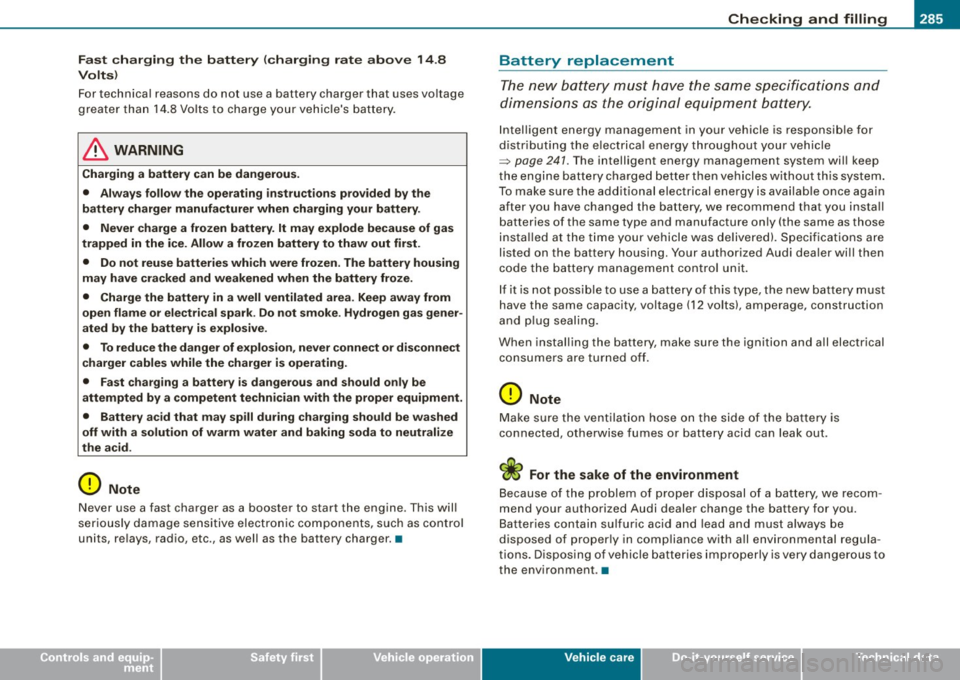
___________________________________________ C_ h_e _c_ k_ i_n _g _ a_n _d_ f_il _li _n _g __ _
•
Fast charging the battery {charging rate above 14 .8
Volts )
For technical reasons do not use a battery charger that uses vo ltage
greater than 1 4.8 Vo lts to charge y our ve hic le 's battery.
& WARNING
Charging a battery can be dangerous .
• Always follow the operating instruct ions provided by the
battery charger manufacturer when charging your battery.
• Never charge a frozen battery. It may explode because of gas
trapped in the ice . Allow a frozen battery to thaw out first.
• Do not reuse batteries which were frozen. The battery housing
may have cracked and weakened when the battery froze .
• Charge the battery in a well ventilated area. Keep away from
open flame or electrical spark . Do not smoke . Hydrogen gas gener
ated by the battery is explosive.
• To redu ce the danger of e xplos ion , never connect or disconnect
charger cables while the charger i s operating.
• Fast charging a battery is dangerous and should only be
attempted by a competent technician with the proper equipment.
• Battery acid that may spill during charging should be washed
off with a solution of warm water and baking soda to neutralize
the acid .
0 Note
Never use a fast charger as a booster to start the engine . T his wil l
se rious ly da mage sen sit ive elec tronic componen ts, such a s control
un its, re lays, radio, etc., as well as the battery charger. •
Battery replacement
Th e ne w batt ery must hav e the sam e speci ficat ions and
d im en sions as t he o rigin al equi pmen t b att ery.
Intel ligent energy management in your vehicle is respons ib le for
d istr ibut ing t he e lectr ica l energy t hro ugh out your ve hicl e
~ page 241. The intelligent energy management syste m wil l keep
t h e eng ine ba ttery charge d better then veh icles without t his system .
T o make sure the additional electrical energy is available once again
af te r you hav e cha nged the battery, w e re co mmend tha t you in sta ll
batteries of the same type and manufacture on ly (the same as those
i nsta lled at t he time your vehic le was delive re d ). S pecifi cations a re
listed on the battery housing . Your authorized Audi dea ler wi ll then
code the batter y ma nageme nt control u nit.
If it is not poss ible to use a batt ery o f this ty pe, the new ba ttery must
have the same capacity, voltage (12 vo lts) , amperage, constr uction
and p lug sea lin g.
W hen installing the batter y, ma ke sure the ignition and all electrical
c o nsumers are tur ned off .
0 Note
Make sure the ven tilat io n hose on t he side o f the ba ttery is
conn ected, otherwise fumes or b att ery ac id can leak out .
<£' For the sake of the environment
Because of the proble m of proper d isposal o f a ba ttery, we recom
mend your authorized Audi dealer change the battery for you.
B at teri es co nt ain sulf uric acid a nd lead an d mu st alwa ys be
disposed of proper ly in comp liance with a ll environmental regula
t ions. Dispos ing o f v ehicle bat ter ie s i mproper ly is very danger ous to
the environment .•
Vehicle care I t •